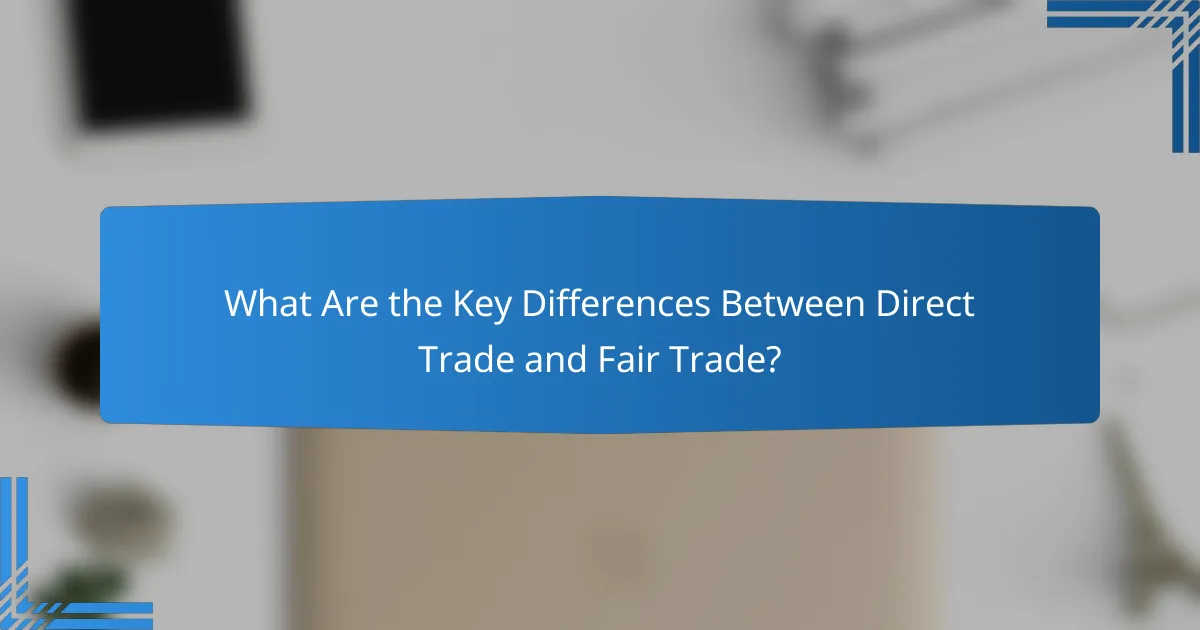Direct Trade and Fair Trade both aim to support producers but differ in their methodologies. Direct Trade fosters personal relationships between buyers and producers, often leading to higher quality products, while Fair Trade focuses on established ethical standards and certifications to ensure fair practices and community support. Understanding when to use each approach can help consumers make informed choices that align with their values and priorities.

What Are the Key Differences Between Direct Trade and Fair Trade?
Direct Trade and Fair Trade both aim to support producers, but they differ in their approaches. Direct Trade focuses on personal relationships between buyers and producers, while Fair Trade emphasizes established ethical standards and certifications to ensure fair practices.
Direct Trade focuses on direct relationships with producers
Direct Trade involves coffee roasters or buyers establishing personal connections with farmers. This approach allows for better communication and understanding of the producers’ needs, leading to more tailored support. Buyers often visit farms to build relationships and negotiate prices directly, which can foster trust and transparency.
For example, a roaster might work with a specific coffee farm in Colombia, visiting annually to discuss quality and pricing. This direct interaction can enhance the quality of the product and ensure that farmers receive a fair share of the profits.
Fair Trade emphasizes ethical standards and certifications
Fair Trade operates through a certification system that sets specific criteria for ethical sourcing. This includes ensuring that farmers receive a minimum price for their goods, which protects them from market fluctuations. Additionally, Fair Trade promotes sustainable farming practices and community development initiatives.
To be certified, producers must adhere to guidelines that cover labor rights, environmental sustainability, and economic fairness. This certification can be a valuable marketing tool, as consumers often prefer products that align with ethical standards.
Direct Trade often results in higher profits for farmers
Farmers involved in Direct Trade typically earn higher profits compared to traditional trade models. By cutting out intermediaries, producers can negotiate better prices directly with buyers. This model often leads to a more equitable distribution of profits, benefiting the farmers more significantly.
For instance, a farmer might receive 20-30% more for their coffee beans through Direct Trade than through conventional channels, allowing them to invest in their farms and communities.
Fair Trade ensures minimum prices and community development
Fair Trade guarantees that farmers receive a minimum price for their products, which helps protect them from volatile market conditions. This price assurance allows farmers to plan for the future and invest in their operations. Additionally, Fair Trade premiums are often allocated for community development projects, such as education and healthcare.
For example, a Fair Trade coffee cooperative might use its premium to build a school or improve local infrastructure, directly benefiting the community. This focus on development ensures that Fair Trade is not just about fair pricing but also about fostering long-term growth and sustainability.

When Should You Choose Direct Trade?
Choose direct trade when you want to ensure a direct relationship with producers, often resulting in higher quality products and better compensation for farmers. This approach is particularly beneficial for specialty items where quality and ethical sourcing are paramount.
For specialty coffee and artisan products
Direct trade is ideal for specialty coffee and artisan products because it emphasizes quality over quantity. By working directly with producers, you can select beans or goods that meet specific flavor profiles and craftsmanship standards. This often leads to unique offerings that stand out in the market.
When sourcing specialty items, consider visiting farms or workshops to understand their production methods. This firsthand experience can enhance your appreciation of the product and strengthen your brand’s story.
When building personal relationships with producers
Choosing direct trade allows you to cultivate personal relationships with producers, which can lead to mutual trust and collaboration. This connection often results in better communication about quality expectations and production practices.
To foster these relationships, engage in regular visits or communication with producers. This not only helps in negotiating fair prices but also encourages transparency in the supply chain, benefiting both parties in the long run.

When Is Fair Trade the Better Option?
Fair Trade is often the better choice when ethical sourcing and community support are priorities. It ensures that producers receive fair compensation and work under safe conditions, fostering transparency in the supply chain.
For guaranteed ethical sourcing and transparency
Fair Trade certification provides a reliable framework for ethical sourcing, ensuring that products meet specific social, environmental, and economic standards. This certification process typically involves regular audits and compliance checks, which help maintain transparency throughout the supply chain.
When purchasing Fair Trade products, consumers can trust that the producers are paid fairly and work in safe conditions. This is particularly important for goods like coffee, chocolate, and handicrafts, where ethical concerns are prevalent.
When supporting marginalized communities
Fair Trade is especially beneficial for marginalized communities that often lack access to fair market practices. By choosing Fair Trade products, consumers directly contribute to the economic empowerment of these communities, helping them to achieve better living standards.
For example, buying Fair Trade coffee from smallholder farmers in developing countries can significantly improve their livelihoods. These farmers receive a minimum price for their products, which helps them invest in education, healthcare, and sustainable farming practices.

What Are the Benefits of Direct Trade?
Direct trade offers several advantages, including improved product quality and enhanced pricing flexibility. By connecting producers directly with buyers, this model fosters better relationships and allows for more tailored sourcing strategies.
Higher quality products through direct sourcing
Direct trade often results in higher quality products because it allows buyers to select specific farms or producers known for their superior practices. This direct relationship enables buyers to communicate their quality standards and receive feedback, ensuring that the end product meets expectations.
For example, coffee sourced directly from a specific farm can be fresher and more flavorful than coffee purchased through intermediaries. Buyers can establish quality benchmarks and even participate in the production process, leading to a more refined product.
Greater flexibility in pricing and production
Direct trade provides greater flexibility in pricing and production schedules, allowing producers to negotiate terms that reflect their costs and market conditions. This adaptability can lead to fairer compensation for farmers, as they are not bound by rigid pricing structures imposed by middlemen.
Additionally, producers can adjust their production based on direct feedback from buyers, enabling them to respond quickly to market demands. For instance, if a buyer requests a specific type of product, the producer can pivot their production efforts without the delays typical in traditional trade models.

What Are the Benefits of Fair Trade?
Fair Trade offers several advantages, primarily focusing on equitable compensation for producers and promoting ethical sourcing. By ensuring fair wages and sustainable practices, Fair Trade helps improve the livelihoods of farmers and artisans while fostering environmental stewardship.
Ensures fair wages for producers
One of the core benefits of Fair Trade is the guarantee of fair wages for producers, which often translates to higher income compared to conventional trade practices. This ensures that farmers can meet their basic needs and invest in their communities, leading to improved quality of life.
Fair Trade standards typically require that producers receive a minimum price for their goods, which protects them from volatile market fluctuations. For example, coffee farmers under Fair Trade agreements may earn a price that is significantly above market rates, allowing them to sustain their livelihoods even during economic downturns.
Promotes sustainable farming practices
Fair Trade encourages sustainable farming techniques that protect the environment and promote biodiversity. Producers are often trained in organic farming methods, reducing reliance on harmful pesticides and fertilizers, which benefits both the land and the health of local communities.
Additionally, Fair Trade certification often includes requirements for environmental stewardship, such as maintaining soil health and conserving water resources. This not only helps in preserving ecosystems but also enhances the long-term viability of farming operations, ensuring that future generations can continue to farm sustainably.

How Do Pricing Models Compare?
Direct Trade and Fair Trade pricing models differ significantly in their approach to compensation for producers. Direct Trade often allows for flexible pricing based on negotiations, while Fair Trade establishes fixed minimum prices to ensure a baseline income for farmers.
Direct Trade pricing is often negotiable
In Direct Trade, buyers typically negotiate prices directly with producers, which can lead to higher earnings for farmers if they can demonstrate quality or unique offerings. This model encourages personal relationships and transparency, allowing producers to set prices that reflect their costs and desired profits.
For example, a coffee roaster might pay a premium for beans sourced directly from a specific farm, resulting in prices that can vary widely based on quality and market demand. This flexibility can benefit both parties but may also lead to inconsistencies in income for producers.
Fair Trade has set minimum prices
Fair Trade pricing is structured around established minimum prices that ensure producers receive a fair wage, regardless of market fluctuations. This model aims to protect farmers from volatile market conditions and provides a more stable income.
For instance, the Fair Trade minimum price for coffee is often set around $1.40 per pound, with additional premiums for organic certification. This guarantees that even in low market periods, farmers can cover their basic costs and sustain their livelihoods.

What Are the Challenges of Direct Trade?
Direct trade presents several challenges, primarily related to transparency, consistency, and the complexities of sourcing. While it aims to create a closer relationship between producers and consumers, navigating these connections can be difficult and resource-intensive.
Transparency Issues
One of the main challenges in direct trade is ensuring transparency throughout the supply chain. Consumers often seek to understand the origins of their products and the conditions under which they were produced. However, without established certifications or oversight, verifying claims made by producers can be complicated.
Quality Control
Maintaining consistent quality can be difficult in direct trade arrangements. Producers may vary in their practices and standards, leading to fluctuations in product quality. Buyers must invest time and resources to establish reliable quality benchmarks and ensure that these are met consistently.
Resource Intensity
Direct trade often requires more time and effort than traditional trade methods. Establishing relationships with producers, negotiating terms, and managing logistics can be labor-intensive. Businesses should weigh the benefits of direct trade against the potential for increased operational demands.
Market Access
Producers in direct trade may face challenges accessing broader markets. While direct relationships can enhance consumer loyalty, they may limit exposure to larger retail channels. Companies must consider how to balance direct trade with other sales strategies to maximize reach and impact.
